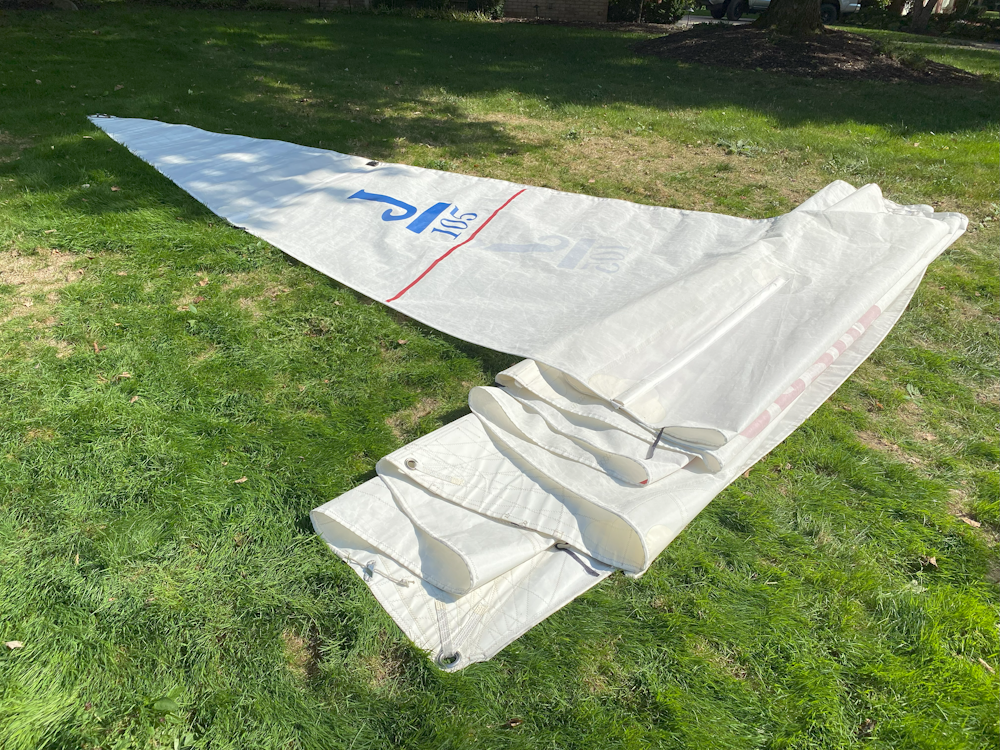Determining the dollar value of a used sail requires a nuanced understanding of several factors, as the worth of such an item isn’t simply based on age or size
Basic Price Guide For Used Cruising Sails
- After one season of use – Reduce sail value by 30% – 50%.
- After two season of use – Reduce sail value by 30% – 50% of season 1 value.
- After three seasons of use – Reduce sail value by 30% – 50% of season 2 value.
- Continue this process for the age of your sail.
*The reduction percentage given is a general guide for used cruising sails. Used racing sails can have a wider range in value depending on the sails’ cut and material fibers. Sail damage and repairs needed also play a large factor in a used sails value.
 Further Determine Your Used Sails’ Value
Further Determine Your Used Sails’ Value
Here’s a further step-by-step guide to help you determine how much a used sail is worth:
1. Sail Specifications:
- Material: The type of material (e.g., Dacron, Mylar, Kevlar, or laminate) plays a role in the sail’s durability and, subsequently, its value.
- Size: Typically measured by the sail’s luff, leech, and foot. Bigger sails generally cost more, but condition and material often play a more significant role in determining value.
2. Age and Use:
- Manufacturing Date: Many sails have a tag or mark indicating their production year.
- Usage: A sail used frequently for racing will wear out faster than a day-sailor’s sail.
3. Condition:
- Check for UV damage, which can degrade the sail’s fibers.
- Look for tears, stains, mildew, or patches. A sail in mint condition is obviously worth more.
- Assess the stitching. If it’s coming apart, it indicates wear and the potential need for repairs.
- Examine the hardware, like grommets or slides, for wear or corrosion.
4. Brand and Reputation:
- Well-respected sailmakers’ products will generally hold a higher resale value than generic brands.
5. Modifications and Repairs:
- Quality Repairs: These can maintain or even boost a sail’s value if done professionally.
- Modifications: Depending on the change, it can either increase or decrease the sail’s value.
6.  Market Research:
Market Research:
- Browse online forums, sailing classifieds, or eBay to find comparable sails. This will give you a ballpark figure.
- Visit local sail lofts or marine consignment stores. They might have similar sails and can offer insight into current market prices.
7. Demand and Seasonality:
- Sailing gear might fetch a higher price during peak sailing seasons.
- If there’s a high demand for a particular type or size of sail in your area, it can drive up its value.
8. Consultation:
- Consult a SailTrader Certified sailmaker. They can give you a clearer understanding of your sail’s worth in the current market.
9. Presentation:
- If selling, clean the sail and take clear, high-quality photos. The way you present the sail can impact perceived value.
10. Pricing Strategy:
- Fixed Price: Based on your research, set a price you believe is fair.
- OBO (Or Best Offer): Allows potential buyers to negotiate, possibly leading to a quicker sale.
11. Documentation:
- If you have any documentation about the sail’s history, repairs, or specifications, it can enhance your sail’s credibility and value.
While this guide gives you a foundation to determine the dollar value of a used sail, remember that the market can be subjective. Patience, research, and flexibility will serve you well in finding the right price point.

